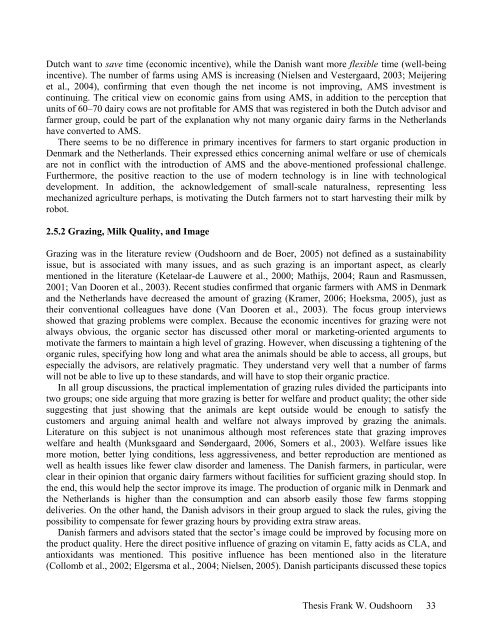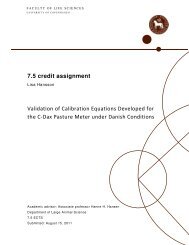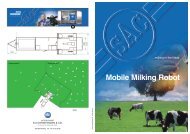Innovative Technology and Sustainable Development of Organic - 1.
Innovative Technology and Sustainable Development of Organic - 1.
Innovative Technology and Sustainable Development of Organic - 1.
You also want an ePaper? Increase the reach of your titles
YUMPU automatically turns print PDFs into web optimized ePapers that Google loves.
Dutch want to save time (economic incentive), while the Danish want more flexible time (well-being<br />
incentive). The number <strong>of</strong> farms using AMS is increasing (Nielsen <strong>and</strong> Vestergaard, 2003; Meijering<br />
et al., 2004), confirming that even though the net income is not improving, AMS investment is<br />
continuing. The critical view on economic gains from using AMS, in addition to the perception that<br />
units <strong>of</strong> 60–70 dairy cows are not pr<strong>of</strong>itable for AMS that was registered in both the Dutch advisor <strong>and</strong><br />
farmer group, could be part <strong>of</strong> the explanation why not many organic dairy farms in the Netherl<strong>and</strong>s<br />
have converted to AMS.<br />
There seems to be no difference in primary incentives for farmers to start organic production in<br />
Denmark <strong>and</strong> the Netherl<strong>and</strong>s. Their expressed ethics concerning animal welfare or use <strong>of</strong> chemicals<br />
are not in conflict with the introduction <strong>of</strong> AMS <strong>and</strong> the above-mentioned pr<strong>of</strong>essional challenge.<br />
Furthermore, the positive reaction to the use <strong>of</strong> modern technology is in line with technological<br />
development. In addition, the acknowledgement <strong>of</strong> small-scale naturalness, representing less<br />
mechanized agriculture perhaps, is motivating the Dutch farmers not to start harvesting their milk by<br />
robot.<br />
2.5.2 Grazing, Milk Quality, <strong>and</strong> Image<br />
Grazing was in the literature review (Oudshoorn <strong>and</strong> de Boer, 2005) not defined as a sustainability<br />
issue, but is associated with many issues, <strong>and</strong> as such grazing is an important aspect, as clearly<br />
mentioned in the literature (Ketelaar-de Lauwere et al., 2000; Mathijs, 2004; Raun <strong>and</strong> Rasmussen,<br />
2001; Van Dooren et al., 2003). Recent studies confirmed that organic farmers with AMS in Denmark<br />
<strong>and</strong> the Netherl<strong>and</strong>s have decreased the amount <strong>of</strong> grazing (Kramer, 2006; Hoeksma, 2005), just as<br />
their conventional colleagues have done (Van Dooren et al., 2003). The focus group interviews<br />
showed that grazing problems were complex. Because the economic incentives for grazing were not<br />
always obvious, the organic sector has discussed other moral or marketing-oriented arguments to<br />
motivate the farmers to maintain a high level <strong>of</strong> grazing. However, when discussing a tightening <strong>of</strong> the<br />
organic rules, specifying how long <strong>and</strong> what area the animals should be able to access, all groups, but<br />
especially the advisors, are relatively pragmatic. They underst<strong>and</strong> very well that a number <strong>of</strong> farms<br />
will not be able to live up to these st<strong>and</strong>ards, <strong>and</strong> will have to stop their organic practice.<br />
In all group discussions, the practical implementation <strong>of</strong> grazing rules divided the participants into<br />
two groups; one side arguing that more grazing is better for welfare <strong>and</strong> product quality; the other side<br />
suggesting that just showing that the animals are kept outside would be enough to satisfy the<br />
customers <strong>and</strong> arguing animal health <strong>and</strong> welfare not always improved by grazing the animals.<br />
Literature on this subject is not unanimous although most references state that grazing improves<br />
welfare <strong>and</strong> health (Munksgaard <strong>and</strong> Søndergaard, 2006, Somers et al., 2003). Welfare issues like<br />
more motion, better lying conditions, less aggressiveness, <strong>and</strong> better reproduction are mentioned as<br />
well as health issues like fewer claw disorder <strong>and</strong> lameness. The Danish farmers, in particular, were<br />
clear in their opinion that organic dairy farmers without facilities for sufficient grazing should stop. In<br />
the end, this would help the sector improve its image. The production <strong>of</strong> organic milk in Denmark <strong>and</strong><br />
the Netherl<strong>and</strong>s is higher than the consumption <strong>and</strong> can absorb easily those few farms stopping<br />
deliveries. On the other h<strong>and</strong>, the Danish advisors in their group argued to slack the rules, giving the<br />
possibility to compensate for fewer grazing hours by providing extra straw areas.<br />
Danish farmers <strong>and</strong> advisors stated that the sector’s image could be improved by focusing more on<br />
the product quality. Here the direct positive influence <strong>of</strong> grazing on vitamin E, fatty acids as CLA, <strong>and</strong><br />
antioxidants was mentioned. This positive influence has been mentioned also in the literature<br />
(Collomb et al., 2002; Elgersma et al., 2004; Nielsen, 2005). Danish participants discussed these topics<br />
Thesis Frank W. Oudshoorn 33




